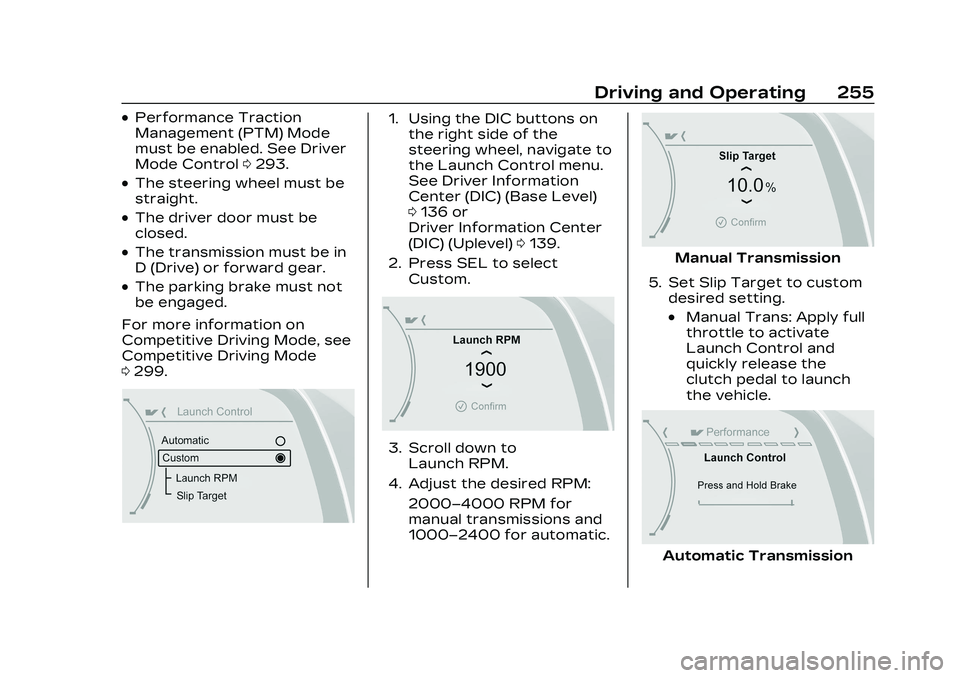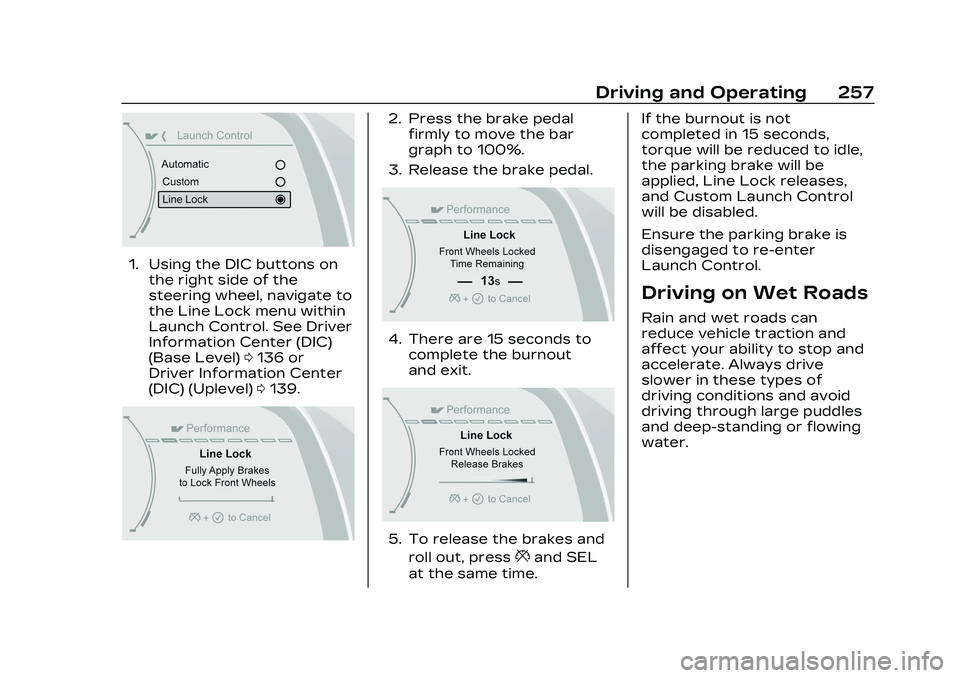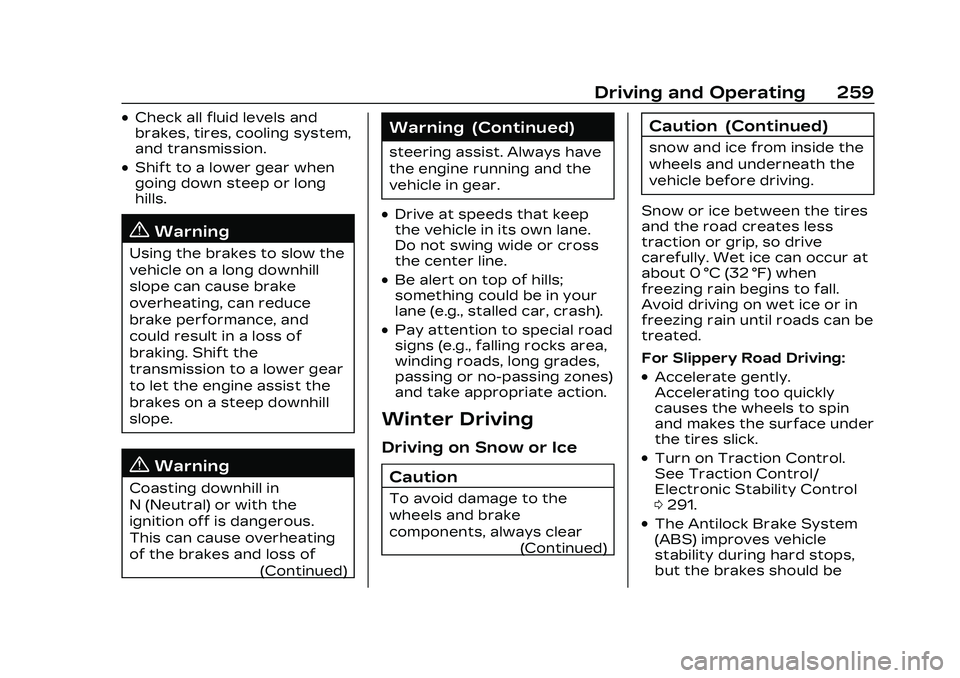CADILLAC CT5 2023 Owners Manual
Manufacturer: CADILLAC, Model Year: 2023, Model line: CT5, Model: CADILLAC CT5 2023Pages: 526, PDF Size: 6.85 MB
Page 251 of 526

Cadillac CT5 Owner Manual (GMNA-Localizing-U.S./Canada-16500419) -
2023 - CRC - 5/10/22
250 Driving and Operating
3. Front Brake Cooling Duct
Brake Pad Wear Sensors
If equipped, the brake pad
wear sensors need to be
removed from the brake
calipers prior to any track or
racing event. The original
sensors can be reinstalled if
significant brake pad wear is
not observed. Refer to Brake
Pad Life System (If Equipped)
0 403. If the sensors are not
reinstalled after the track
event, install brake pad wear
sensor plugs. See your dealer. The V-Series Blackwing is
equipped with brake pad wear
sensors which are track
capable and should not be
disabled for track and racing.
A message will display in the
Driver Information Center
(DIC) when the brake pads
show excessive wear.
Brake Fluid
Replace existing brake fluid
with a qualified DOT 4 high
performance brake fluid from
a sealed container. Brake fluid
with a dry boiling point >310 °C
(590 °F) is qualified. If high
performance brake fluid is
used, replace it with GM
approved brake fluid before
driving on public roads. If high
performance brake fluid is in
the vehicle and the age of the
brake fluid is over a month old
or unknown, replace the brake
fluid before track events and
competitive driving. Do not use
silicone or DOT 5 brake fluids.
It is critical to disconnect the
battery before bleeding the
system, replacing the pads,
or any other work. The battery
must be disconnected to
prevent the brake master
cylinder from pressurizing the
hydraulic system during its
automated self diagnostic
tests that can possibly occur
when a door is opened or the
remote key is present.
Check the fluid level before
each competitive driving
event.
Brake System Flushing &
Bleeding
The J56 brake system
requires specific processes
for bleeding and fluid flushing.
These can be found in the
service manual.
Properly bleeding the brake
system is required for proper
operation of the hydraulic
brake system.
Page 252 of 526

Cadillac CT5 Owner Manual (GMNA-Localizing-U.S./Canada-16500419) -
2023 - CRC - 5/10/22
Driving and Operating 251
Brake Leak Detection
The hydraulic braking system
has advanced diagnostic
capability to help detect
hydraulic leaks, trapped air,
and other performance issues.
These diagnostics are active
when the hydraulic system is
powered. In order to avoid
inadvertently setting a leak
Diagnostic Trouble Code
(DTC), disconnect the battery
before servicing the brake
system.
If the vehicle sets a DTC
related to a brake system leak,
the Brake System Warning
Light will come on and vehicle
speed may be limited to 100
kph (62 mph). Any time a leak
DTC is set, the vehicle should
be inspected carefully for
evidence of a leak and should
be repaired immediately. See
your dealer.Brake Fade Warning Assist
The Brake Fade Warning
Assist system monitors the
performance of the brake
system. If the system detects
brake fade, or if the brake fluid
is near the boiling point, the
driver will be alerted.
The Brake Fade Warning
Assist system is designed for
use with the factory-installed
brake pads or GM approved
replacement pads. If the brake
pads on the vehicle need to be
replaced, use GM approved
brake pads. If this is not done,
the brake fade warning
system may not function
properly.
Stage 1 :
The DIC displays a
“Reduce Braking to Avoid
Overheating” message, a
chime sounds and brake pedal
effort and travel is increased.
When the message displays,
the driver should back up
braking points and reduce
brake usage in order to reduce brake temperature. This will
allow for continued lapping
with no speed limitations.
Stage 2 :
The DIC displays a
Brakes Overheated Service
Now message, a chime
sounds, and brake pedal effort
and travel is further increased.
This code indicates that the
brake fluid temperature is
excessive and is about to boil.
The system limits vehicle
speed to 100 km/h (62 mph).
The driver should immediately
start a cool down lap if on the
track. If this message displays,
the vehicle needs to be
serviced. The brake system
needs to cool down, and the
brake fluid must be
immediately flushed with DOT
4 for street use, or to a
qualified DOT 4 race fluid for
track use. Boiled brake fluid is
compromised and must be
replaced.
Page 253 of 526

Cadillac CT5 Owner Manual (GMNA-Localizing-U.S./Canada-16500419) -
2023 - CRC - 5/10/22
252 Driving and Operating
Brake Burnishing
New brake pads must be
burnished before racing or
other competitive driving.
Caution
These procedures are
specific to the V-Series with
performance brake linings
package. This procedure
should not be run on other
models as damage may
result.
Caution
The new vehicle break-in
period should be completed
before performing the brake
burnishing procedure or
damage may occur to the
powertrain/engine. See New
Vehicle Break-In0265.
Caution
Brake pedal fade will occur
during any track burnish
procedure and can cause
brake pedal travel and force
to increase. This could
extend stopping distance
until the brakes are fully
burnished.
When performed as
instructed, these procedures
will not damage the brakes.
During the burnishing
procedure, the brake pads will
smoke and produce an odor.
The braking force and pedal
travel may increase. After the
procedure is complete, the
brake pads may appear white
at the rotor contact.
Perform these procedures in a
safe manner and in compliance
with all local and state
ordinances/laws regarding
motor vehicle operation.
Perform the procedures only
on dry pavement. As with all high performance
brake systems, some amount
of brake squeal is normal.
Street High Performance
Brake Burnishing Procedure
This section is for the V-Series
Blackwing with J57 carbon
ceramic brake rotors only.
This procedure should only be
run on a track or other
non-public area, and only on
dry pavement.
Caution
Brake fade will occur during
this track burnish procedure
and can cause brake pedal
travel and force to increase.
This could extend stopping
distance until the brakes are
fully burnished.
1. From a stop, accelerate as rapidly as possible without
activating traction control
to a speed of 100 km/h
(60 mph).
Page 254 of 526

Cadillac CT5 Owner Manual (GMNA-Localizing-U.S./Canada-16500419) -
2023 - CRC - 5/10/22
Driving and Operating 253
2. Using the G-Force Gaugein the HUD display, use
enough pedal force to
completely stop the vehicle
in four to five seconds.
(~0.7g Decel level to stop
the vehicle in a straight
line). If ABS activates,
braking is too hard.
3. Repeat the first two steps 20 consecutive times, this
should take about
five minutes.
4. After completing the 20 stops, cool the brakes by
driving for 8 km (5 mi) at
100 km/h (60 mph).
Alternative Closed Course
Brake Burnishing Procedure
This brake burnish procedure
should only be run on vehicles
with a factory equipped brake
system.
This procedure should only be
run on a track and only on dry
pavement. Brake pedal fade
will occur during this track
burnish procedure and can cause brake pedal travel and
force to increase. This could
extend stopping distance until
the brakes are fully burnished.
1. Start track lapping at lower speeds and lower
braking efforts for
three minutes of driving.
Allow for increased braking
distances due to reduced
brake output.
2. After Step 1, increase speed and braking effort
for the next six minutes of
lapping, gradually ending
up at 90% effort. Continue
to allow for increased
braking distance due to
reduced brake output.
3. Cool the brakes by lapping with minimal light braking
for six minutes.
Wheel Alignment
Wheel alignment suggested
specs for track use:
Road Course (V-Series)
.Front: -2.0 deg camber,
0.2 deg total toe
.Rear: -1.7 deg camber,
0.2 deg total toe
Road Course (V-Series
Blackwing)
.Front: -2.5 deg camber,
0.1 deg total toe
.Rear: -1.5 deg camber,
0.1 deg total toe
Tire Inflation Pressure
Guidelines
Tire inflation pressures affect
vehicle handling and tire life,
and should be adjusted for
various types of tracks/
courses.
Inspect the tires prior to every
track/course session. Track/
course driving will reduce the
tire tread life.
To maximize tire life, drive
800 km (500 mi) prior to
racetrack driving or complete
the minimum track running
that will increase the tire
pressures by 35 kPa (5 psi).
After this, immediately let the
tires cool to cold pressures.
Page 255 of 526

Cadillac CT5 Owner Manual (GMNA-Localizing-U.S./Canada-16500419) -
2023 - CRC - 5/10/22
254 Driving and Operating
Tire Inflation Pressure High
Speed
See Tire Pressure for
High-Speed Operation0429.
Tire Inflation Pressure for
Track Driving
For driving on a race course,
if the vehicle is equipped with
275/35ZR19 (100Y) and
305/30ZR19 (102Y) tires, set
the cold (stationary) tire
pressures to 28 psi. During
track sessions, set the tire
pressures at 35 to 38 psi for
hot tires. If pressures exceed
38 psi, adjust the pressures
down to 35 to 38 psi. Return
the tires to the recommended
cold tire inflation pressure
when track driving has ended.
Driving and Operating
{Warning
Operating the vehicle at high
speeds can be dangerous.
Improper tire inflation
pressure can put additional (Continued)
Warning (Continued)
strain on the tires and can
cause a sudden failure. Make
sure the tires are in
excellent condition, and use
the correct cold tire inflation
pressure for the vehicle load
and track/course.
{Warning
Tracks/courses put high
loads on tires operating at
high speed, which can lead
to tire failure if not inflated
properly. Always limit vehicle
cargo to the driver plus one
passenger with no additional
cargo.
{Warning
Track/course loads wear
tires both on the tread and
internal to the tire. When
driven in track/course(Continued)
Warning (Continued)
conditions, even if tread is
not worn down to the
treadwear indicator, tires
must be replaced after the
equivalent of two tanks of
fuel or approximately 160 km
(100 mi).
Custom Launch Control (If
Equipped)
Custom Launch Control allows
the following parameters for
Launch Control to be modified:
.Launch RPM
.Slip Target (5%–15%)
.Surface Type
To adjust the Launch RPM, all
of these conditions must
be met:
.The vehicle must be in Track
Mode. See “Track Mode”
under Driver Mode Control
0 293.
Page 256 of 526

Cadillac CT5 Owner Manual (GMNA-Localizing-U.S./Canada-16500419) -
2023 - CRC - 5/10/22
Driving and Operating 255
.Performance Traction
Management (PTM) Mode
must be enabled. See Driver
Mode Control0293.
.The steering wheel must be
straight.
.The driver door must be
closed.
.The transmission must be in
D (Drive) or forward gear.
.The parking brake must not
be engaged.
For more information on
Competitive Driving Mode, see
Competitive Driving Mode
0 299.
1. Using the DIC buttons on
the right side of the
steering wheel, navigate to
the Launch Control menu.
See Driver Information
Center (DIC) (Base Level)
0136 or
Driver Information Center
(DIC) (Uplevel) 0139.
2. Press SEL to select Custom.
3. Scroll down toLaunch RPM.
4. Adjust the desired RPM: 2000–4000 RPM for
manual transmissions and
1000–2400 for automatic.
Manual Transmission
5. Set Slip Target to custom desired setting.
.Manual Trans: Apply full
throttle to activate
Launch Control and
quickly release the
clutch pedal to launch
the vehicle.
Automatic Transmission
Page 257 of 526

Cadillac CT5 Owner Manual (GMNA-Localizing-U.S./Canada-16500419) -
2023 - CRC - 5/10/22
256 Driving and Operating
.Auto Trans: Firmly press
and hold the brake pedal
to activate Launch
Control.
6. Auto Trans Only - Quicklyapply full throttle. Release
the brake pedal to launch
the vehicle.
Line Lock (If Equipped)
{Warning
The vehicle may move
unexpectedly when using
Line Lock, which could cause
injury to persons or property
located nearby. Only use
Line Lock on a closed track
where there is a large clear
(Continued)
Warning (Continued)
area around all sides of the
vehicle. Be ready to apply
the brakes immediately if the
vehicle begins to move. Do
not use Line Lock in an area
that is accessible to the
public or where people or
property are located near
the vehicle.
Caution
Attempting to shift when
the drive wheels are
spinning and do not have
traction may cause damage
to the transmission. Damage
caused by misuse of the
vehicle is not covered by the
vehicle warranty. Do not
attempt to shift when the
drive wheels do not have
traction. Line Lock allows for locking
the front brakes
independently of the rear
brakes. This allows the rear
tires to spin when the throttle
is applied.
To enter Line Lock, all of
these conditions must be met:
.The vehicle must be in
Track Mode.
.Performance Traction
Management (PTM) Mode
must be enabled.
.The steering wheel must be
straight.
.The driver door must be
closed.
.The vehicle must be in D
(Drive) for an automatic
transmission or 1 (First) gear
for a manual transmission.
.The parking brake must not
be engaged.
.The vehicle must be stopped
on level ground. The
accelerator pedal must not
be applied.
Page 258 of 526

Cadillac CT5 Owner Manual (GMNA-Localizing-U.S./Canada-16500419) -
2023 - CRC - 5/10/22
Driving and Operating 257
1. Using the DIC buttons onthe right side of the
steering wheel, navigate to
the Line Lock menu within
Launch Control. See Driver
Information Center (DIC)
(Base Level) 0136 or
Driver Information Center
(DIC) (Uplevel) 0139.
2. Press the brake pedal
firmly to move the bar
graph to 100%.
3. Release the brake pedal.
4. There are 15 seconds to complete the burnout
and exit.
5. To release the brakes and
roll out, press
*and SEL
at the same time. If the burnout is not
completed in 15 seconds,
torque will be reduced to idle,
the parking brake will be
applied, Line Lock releases,
and Custom Launch Control
will be disabled.
Ensure the parking brake is
disengaged to re-enter
Launch Control.
Driving on Wet Roads
Rain and wet roads can
reduce vehicle traction and
affect your ability to stop and
accelerate. Always drive
slower in these types of
driving conditions and avoid
driving through large puddles
and deep-standing or flowing
water.
Page 259 of 526

Cadillac CT5 Owner Manual (GMNA-Localizing-U.S./Canada-16500419) -
2023 - CRC - 5/10/22
258 Driving and Operating
{Warning
Wet brakes can cause
crashes. They might not
work as well in a quick stop
and could cause pulling to
one side. You could lose
control of the vehicle.
After driving through a large
puddle of water or a car/
vehicle wash, lightly apply
the brake pedal until the
brakes work normally.
Flowing or rushing water
creates strong forces.
Driving through flowing
water could cause the
vehicle to be carried away.
If this happens, you and
other vehicle occupants
could drown. Do not ignore
police warnings and be very
cautious about trying to
drive through flowing water.
Caution
Driving through deep
puddles or standing water
can cause water to come in
through the engine air intake
and damage the engine.
If deep puddles or standing
water cannot be avoided,
proceed with caution and do
not exceed 8 km/h (5 mph).
Do not drive through water
that may come close to or
cover the vehicle’s
underbody.
Hydroplaning
Hydroplaning is dangerous.
Water can build up under the
vehicle's tires so they actually
ride on the water. This can
happen if the road is wet
enough and you are going fast
enough. When the vehicle is
hydroplaning, it has little or no
contact with the road.There is no hard and fast rule
about hydroplaning. The best
advice is to slow down when
the road is wet.
Other Rainy Weather Tips
Besides slowing down, other
wet weather driving tips
include:
.Allow extra following
distance.
.Pass with caution.
.Keep windshield wiping
equipment in good shape.
.Keep the windshield washer
fluid reservoir filled.
.Have good tires with proper
tread depth. See Tires
0418.
.Turn off cruise control.
Hill and Mountain
Roads
Driving on steep hills or
through mountains is different
than driving on flat or rolling
terrain. Tips include:
.Keep the vehicle serviced
and in good shape.
Page 260 of 526

Cadillac CT5 Owner Manual (GMNA-Localizing-U.S./Canada-16500419) -
2023 - CRC - 5/10/22
Driving and Operating 259
.Check all fluid levels and
brakes, tires, cooling system,
and transmission.
.Shift to a lower gear when
going down steep or long
hills.
{Warning
Using the brakes to slow the
vehicle on a long downhill
slope can cause brake
overheating, can reduce
brake performance, and
could result in a loss of
braking. Shift the
transmission to a lower gear
to let the engine assist the
brakes on a steep downhill
slope.
{Warning
Coasting downhill in
N (Neutral) or with the
ignition off is dangerous.
This can cause overheating
of the brakes and loss of(Continued)
Warning (Continued)
steering assist. Always have
the engine running and the
vehicle in gear.
.Drive at speeds that keep
the vehicle in its own lane.
Do not swing wide or cross
the center line.
.Be alert on top of hills;
something could be in your
lane (e.g., stalled car, crash).
.Pay attention to special road
signs (e.g., falling rocks area,
winding roads, long grades,
passing or no-passing zones)
and take appropriate action.
Winter Driving
Driving on Snow or Ice
Caution
To avoid damage to the
wheels and brake
components, always clear (Continued)
Caution (Continued)
snow and ice from inside the
wheels and underneath the
vehicle before driving.
Snow or ice between the tires
and the road creates less
traction or grip, so drive
carefully. Wet ice can occur at
about 0 °C (32 °F) when
freezing rain begins to fall.
Avoid driving on wet ice or in
freezing rain until roads can be
treated.
For Slippery Road Driving:
.Accelerate gently.
Accelerating too quickly
causes the wheels to spin
and makes the surface under
the tires slick.
.Turn on Traction Control.
See Traction Control/
Electronic Stability Control
0 291.
.The Antilock Brake System
(ABS) improves vehicle
stability during hard stops,
but the brakes should be